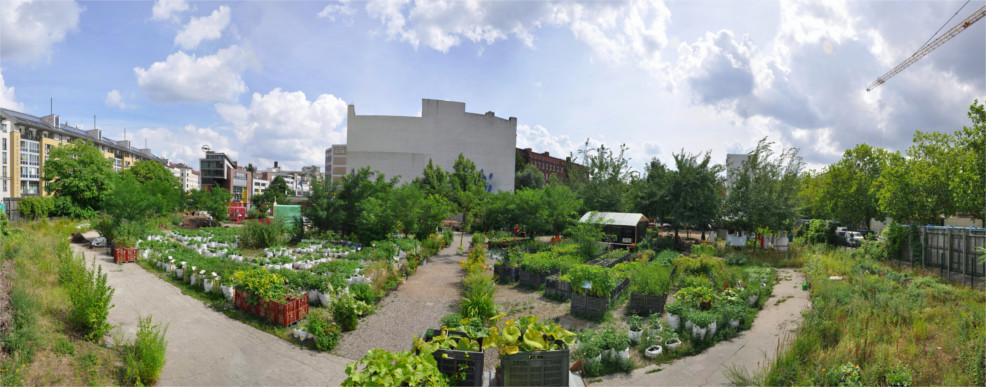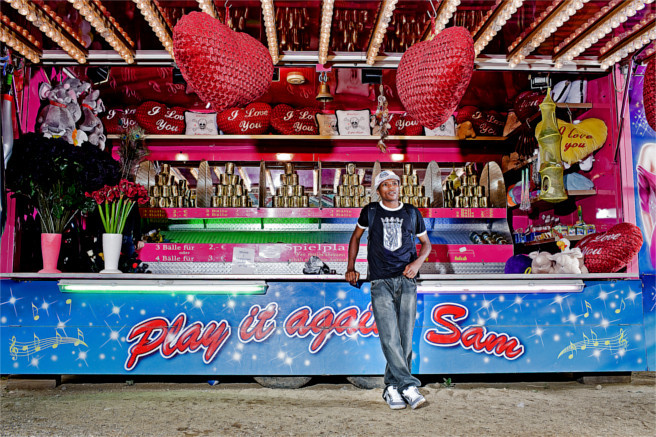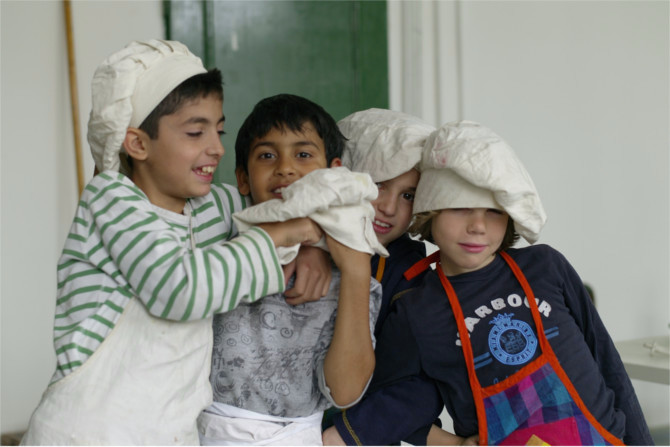
WHAT IS COMMUNITY?
by Francesca Weber-Newth
Community is a shifty concept. It is immoral to reject and difficult to define. "Community" is the concept that binds the chapters in this book together. Do we know what is actually is? As a preface to the Community Lover's Guide to Berlin, I want to consider what 'community' might mean, and, in doing so, point towards a common thread fo the chapters in this book.
READ MORE IN ENGLISH.

PRINZESSINNENGARTEN
by Marco Clausen
I want to take this opportunity to talk about the potential and the limits of 'temporary use' projects. I also want to talk urban agriculture as an important element of creating a 'resilient city'. I was focussed on telling the stories of the little children digging in the city soil, and to their complete surprise and with utter joy, finding potatoes. This scenario is actually one of the most rewarding experiences you can have in creating a city garden. But I want to go beyond this idyllic picture of growing food in the inner city. In adressing the question of access to land, I want to show that underneath the raised beds of an urban garden, you might find some political questions.

KULTURLABOR TRIAL & ERROR
by Julia Vernersson & Ruta Vimba
In february 2010 two friends felt the need to create something that would impact on what they saw as a dysfunctional system of exploiting resources. Their idea was to bring people from varying backgrounds together to re-think the value of material things, and to change attitudes. The alarming sings of the global environment indicated that change needed to take place locally where the two friends lived - in the Berlin borough of Neukölln. In the spring of 2010 this idea started to take shape, culminating in the launch of the collective Kulturlabor Trail & Error.
READ MORE IN ENGLISH.

BERLIN SUMMT!
by Corinna Hölzer & Cornelis Hemmer
Since spring 2011, the bees above the Berlin skyline have been buzzing somewhat louder than before. The initiatieve Berlin Summt! has ensured that bee colonies have found new homes in fifteen prestigious city locations, mainly on their rooftops. These include buildings that house political, cultural, religious, economic and scientific activities: the Berlin City Parliament (Berliner Abgeordnetenhaus), the Museum of Instruments, the Berlin Dome and the Humboldt University's canteen.
These extraordinary locations have drawn the attention of the media towards the bees. We have given around 70 interviews in total, resulting in hundreds of articles in magazines, newspapers and the internet. In addition there have been a dozen radio and TV reports. Even the Arab tv channel, Al Jazeera, has covered the Berlin bees. Thanks to all the publicity, beekeeping has become an important topic of discussion in the city.
READ MORE IN ENGLISH.

EXROTAPRINT
by Daniele Brahm and Les Schliesser
ExRotaprint is a non-profit company that is sustainably developing the site of the former Rotaprint printing press factory in Berlin's Wedding district. Following the insolvency of Rotaprint in 1989, the 10000 square metres premises fell into a state of neglect, and subsequently lingered in line for potential redevelopment.
In 2005 we formulated a concept for taking over the property, while keeping the longstanding tenants already on site. The goal was to develop the space to serve a heterogeneous mix of Arbeit, Kunst, Soziales (work, art and community)
READ MORE IN ENGLISH.

RÜTLI WEAR / MADE IN NEUKÖLLN
by Malte Bergmann
RÜTLI WEAR and MADE IN NEUKÖLNN are community fashion labels born in the Berlin district of Neukölln. These projects involve young people, and aim to create hands on learning experiences and lasting community bonds. It all began with a couple of self-printed t-shirts bearing the letters: RÜTLI. But was has the name of a Swiss mountain meadow got to do with fashion activism?
READ MORE IN ENGLISH.

ZIRKUS CABUWAZI
by Angela Koini
Twenty years ago, some children in the Berlin district of Kreuzberg started to show-off their monocycle skills at schools and street festivals. At that time, nobody suspected that these rather unorganized activities would grow to Europe's largest children and youth circus. Today you can find the colourful tents of Zirkus Cabuwazi in several districts of Berlin: Treptow, Kreuzberg, Friedrichshain, Altglienicke, and Marzahn. However, the spirit of the early days still prevails: the principle that everybody can take part and that the training is free of charge. And most importantly, there is the pleasure of being able to present one's skills and appear on stage.
READ MORE IN ENGLISH.

GARTENSTUDIO
by Malte Zacharias & Per Schumann
Gartenstudio is the name of both our collective, and the physical space we manage in the Naunynstraße in Berlin's Kreuzberg district. We have been there since 2007. Our initial idea was to create an intimate, multifunctional environment in which various community groups could hold meetings, set up offices, and organize projects. We offer people a non-commercial setting to nurture their creativity and to feel comfortable as they would in their home. As the name suggests, Gartenstudio includes a garden filled with beautiful plants, but it also thrives on other activities. These range from cultural and educational work to collaboration with various independent social projects.

BERLINER GAZETTE
by Annika Bunse
There is a great deal of excitement at the Berliner Gazette office in Prenzlauer Berg, Berlin. Office chairs are brought in and arranged around a table, and friendly long-time-no-sees are exchanged. All the walls are plastered with mind-maps and lists, the summaries and evidence of recent discussions. As the twelfth team member finally arrives, the buzz subsides, and everyone sits down, getting ready for the next meeting.
Krystian Woznicki, the publisher of the online newspaper, Berliner Gazette, taps his spoon against a glass; smartphones are switched off and pens are laid out on notebooks. And so begins the monthly critique of our current output, the review of the Berliner Gazette.
READ MORE IN ENGLISH.

UFAFABRIK
by Sigrid Niemer
The ufaFabrik is a cultural oasis in the neighbourhood of the legendary Tempelhof airport. The 18.000 m2 were formerly the home of the UFA motion picture studios, which began producing films during the silent era, including Fritz Lang's Metropolis in 1927. In the 1970's the film company went bankrupt and the site lay abandoned. The space's second life as 'ufaFabrik' started in 1979 when my friends and I peacefully occupied the derelict site. We were young and enthusiastic about our dream of living and working together, committed to arts, creativity and sustainable development. Today the ufaFabrik is open year round to the public, offering recreation and artistic production, a café and a bakery, community activities and ecological projects.
READ MORE IN ENGLISH.

ULA UMSONSTLADEN
by Johannes Dietrich, Nikolai Wolfert & Maike Majewski
In Germany every person, statistically, owns around 10.000 things. This is a good starting point for free shops to function well. Given that "shopaholism" is so widespread, a lot of these items are stored "to be used when the time comes", but al too often this means: never! Our addiction to buying things particularly applies to electronic equipment. "The newest smartphone is out now, I need to have it!" Equally clothes, games, or even books are bought and stored away, with the justification, "When I have the time, I will try it out / invite my friends / read them all ..."
Despite the challenges of going against the grain of mainstream logic, people sometimes make a special effort to make their vision come true. It was from out determination to do this, and our believe in sustainable and collaborative consumption, that the Ula Umsonstladen was born.
READ MORE IN ENGLISH.

NETZWERK FREIER BERLINER PROJEKTRÄUME UND -INITIATIVEN
by Isolde Nagel
Séverine Marguin watches a large number of blue points pop up in rapid succession on the interactive map of Berlin, a conspicuous number of them clustered in the districts of Wedding and Neukölln. Since, 2011, as part of her doctoral dissertation, the Parisian cultural sociologist has been working on her study of Berlin's 'project spaces'. These might be spaces used for exhibitions, film screenings, theater rehearsals or silk-screening printing. According to Marguin, the "myth of Berlin" - in which the city has a vast number of studio spaces for artists - still holds true. She maps out this cluster and described the activities that have taken place in Berlin's contemporary art spaces over the past five years.
READ MORE IN ENGLISH.

JUGENDFARM MORITZHOF
by Stephan Metzner
Jugendfarm Moritzhof - an oasis for children and young people - is located right in the middle of Berlin, between the districs of Prenzlauer Berg and Wedding. It lies on a piece of land where the Berlin Wall ran until 1989, and where today the cock crows, horses neigh and pigs grunt.
When the Berlin Wall came down on 9 November 1989, a large piece of land bordering the district of Prenzlauer Berg was freed up. This was essentially no-man's land between the Berlin Wall and its secondary parallel wall, where the watchtowers stood and where concrete slabs and sandbags defined the space. But people in this densely populated area were keen to see more green space, so they turned the space into a recreational area for the residents. This was done informally and spontaneously: now we might describe what happened as "grassroots activism".
READ MORE IN ENGLISH.

WORKSTATION IDEENWERKSTATT BERLIN
by Frauke Hehl
workstation ideenwerkstatt berlin began in 1998, when "Wiener WochenKlausur", a group of artists, conceived a platform for a diverse collection of other stakeholders to engage in debates about society. The platform now involves an ongoing process of discussion at regular meetings, where concepts as peer economy, commons and urban gardening networks are developed. workstation ideenwerkstatt helps people to realize such projects and to build up networks between them. We exist at the intersection between art, culture and the social and hope to create new models for working together.
READ MORE IN ENGLISH.

FRAUENZENTRUM SCHOKOLADENFABRIK
by Chantal-Fleur Skähr
Jamina Akoua Klein could not imagine life without the Chocolate Factory Women's Centre. "I have basically learned to walk here, as my mother runs the wood workshop at the Schoko Women's Centre." Since then, the 16 year old has made the best use of all the facilities on site. After spending many years at its day-care centre, nowadays she enjoys working up a sweat during fitness class or relaxing with friends in the hamam. "I love it that the Schokoladenfabrik gives us a space strictly reserved for women and girls. That allows us to move more freely, to learn, to dance and study without fearing that guys will judge us. It is like entering an alternative universe, right here in the middle of Berlin."
READ MORE IN ENGLISH.

ID22 - INSTITUTE FOR CREATIVE SUSTAINABILITY
by Michael LaFond
id22 is a non-profit organization supporting sustainable community development. We assist innovative, self-organised housing projects, organize networking events and city tours, produce publications, operate Internet platforms and work with media partners to improve the urban living environment. The following short story, which is a personal one, illustrates the first decade of id22 and its work for creative sustainability in Berlin.
READ MORE IN ENGLISH.

DIE WELTKÜCHE / GRAEFEWIRTSCHAFT
by Heike Birkhölzer
Die Weltküche is not only a restaurant and a pleasant place to spend lunchtime - it is much more. It takes advantage of the diversity of food from all over the world to give unemployed people and refugees the change to have a job and therefore a better future. At the heart of our business is the desire to enable people - especially migrants - to believe in themselves and persuade them that they can shape their future.
The social enterprise "Graefewirtschaft" runs the restaurant, as well as the catering service, and it also provides meals for schools in the local neighbourhood. In its "world kitchen" Berlin migrants from around the globe cook meals, using traditional recipes that their grandmothers have passed on.
READ MORE IN ENGLISH.

KUNST-STOFFE
by Corinna Vosse
Fabric in many different colours, all kinds of paper, metal and wood - these and many more materials are stockpiled in our rooms at the Kunst-Stoffe house. Looking at the materials, you get endless ideas of what could be crafted. You could make a chair, a picture frame, or a bed cover. You might want to build a theatre stage, or plinths for an art exhibition. In our well-equiped project house we provide materials and workshop space to make all these projects happen. And if you need advice on how to use certain tools or how to connect materials, we can help in realizing your ideas. The best thing about this versatile store of materials is that all of it was considered 'waste' before it came to us.
READ MORE IN ENGLISH.

















